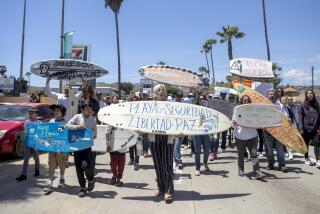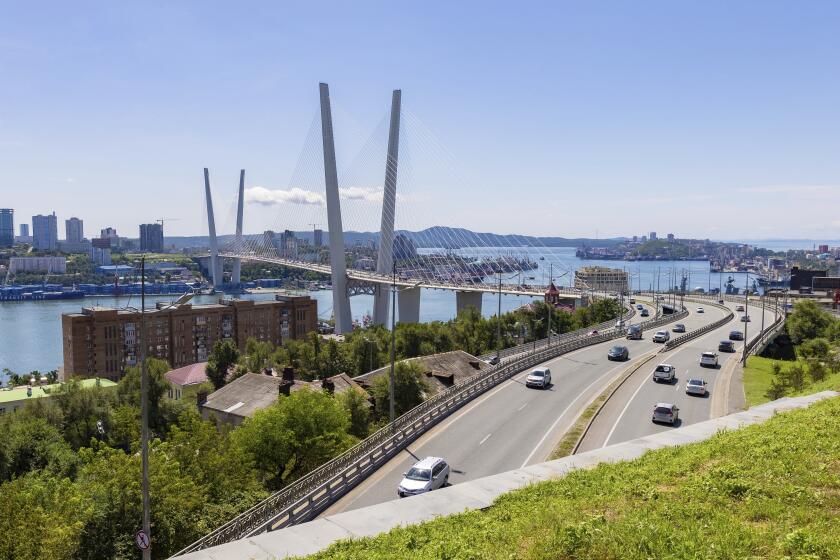Group Aims to Aid the Poor Amid Prosperity : Homelessness: The challenge for Habitat for Humanity’s new chapter is to build housing in an area that is the very symbol of affluence.
Habitat for Humanity International, the nonprofit housing group whose most famous volunteer is former President Jimmy Carter, has helped poor people build their own homes from the South Bronx to Tijuana to Zaire.
But the group’s newest challenge is fighting poverty and homelessness in a community that has long epitomized American suburban affluence--the San Fernando Valley area.
Last week, administrators of the 16-year-old Georgia-based organization officially recognized a new chapter representing the San Fernando and Santa Clarita valleys, where poverty has spread quietly but inexorably in recent years.
There are no burned-out landscapes of desolation in the area, no abandoned urban prairies of the type found in poor neighborhoods elsewhere. But the regional crisis in affordable housing and the recent economic slump--which have pushed many would-be homeowners to the edges of Los Angeles County and many working-class people to the edge of despair--have done their damage.
Of the estimated 60,000 homeless people in the city of Los Angeles, about 20,000 live in the Valley, according to Gary Squier, general manager of the city Department of Housing Preservation and Production. The Valley has at least one-third of the more than 150,000 households in the city in which residents pay more than half their wages for rent, he said.
And although they are hard to count and hard to see, experts say another disadvantaged population keeps growing: families living in crowded and run-down houses and apartments in North Hollywood, converted garages in San Fernando, trailer parks in Newhall. Families forced to sleep on the floor, cook on hot plates and remain only a few paychecks away from homelessness.
“It’s easy to live in the area all your life and commute through the communities of need and never see the need,” said Rachel Dunne, a geologist who helped found the new chapter and who worked with a Habitat project building houses for farmers in Nicaragua two years ago. “It’s very easy not to understand the magnitude of the problem.”
Erica Thomsen, a volunteer employed as a social worker for Los Angeles County Department of Children’s Services in Santa Clarita, said her work has shown her that the problem extends beyond the boundaries of the city of Los Angeles.
“There are pockets of poverty in affluent areas and not far from affluent areas,” she said, describing families that live in tents and move from trailer park to trailer park in the Santa Clarita Valley.
Worldwide, Habitat for Humanity International has built 10,000 dwellings for the poor, most of them in the past several years, said Ken Karlstad, the organization’s director for the Western region of the United States.
Thirty-eight houses have been built in California, Karlstad said. Present projects include a 48-unit condominium complex on land donated by an Orange County developer and at least seven planned houses in Long Beach made possible by a $250,000 grant from that city.
The group, which describes itself as a “housing ministry,” seeks donations of land from private, government and religious groups. Its philosophy is based on the idea of partnership with the working poor, who are assisted by volunteers and free material and expertise both during and after construction. Part of the payment comes in “sweat equity,” based on the new owner’s labor; in California, the houses usually cost about $50,000, with buyers paying no-interest mortgages into a fund for future projects.
“It doesn’t just build homes,” Dunne said. “It enables people to be self-sufficient. It helps build community.”
Dunne and fellow members of the 17-member board of directors, who include professionals and religious leaders, may find their job tougher to pursue than almost anywhere else in Southern California. Even in the most depressed neighborhoods in the Valley, land is scarce and costs a minimum of $80,000 per lot, experts said.
“They face a formidable challenge,” said Arnold Stalk, an architect and developer who runs L. A. Family Housing Corp., a nonprofit group involved in low-income housing. Stalk, who is on the Habitat board, said: “It’s not like the South Bronx, where we could take over an abandoned apartment building and Jimmy Carter can come in with a hammer and do his thing.”
A search for land over the past three months has been unsuccessful so far, Dunne said. But she said the group is still getting organized and is soliciting funds for a targeted annual budget of $150,000.
Members are making the rounds of local homeowner groups, private developers, churches and government officials in Los Angeles and smaller cities including San Fernando, where Habitat workers discussed with officials the possibility of acquiring land in a city redevelopment area.
Although that proposal did not work out, San Fernando City Administrator Mary Strenn said she believes that Habitat can help alleviate the low-income housing crisis, particularly by rehabilitating houses that low-income owners are in danger of losing because they cannot afford to correct code violations.
“Rehabilitation is clearly a need that’s out there,” Strenn said.
And rehabilitation has been a major part of the group’s mission around the world.
“The idea is to be able to save the low-income housing stock we already have,” Dunne said. “For families who can’t afford maintenance, we can help them get a second trust deed.”
Instead of homeowners having to pay for costly repairs all at once, Habitat helps them with a refinancing package that allows them to pay in installments.
In fact, Habitat affiliates such as the Ventura County chapter have had to confine themselves to rehabilitation work because they have been unable to acquire land to build houses. While the land search progresses in the Valley, volunteers have kept busy by painting and refurbishing the Valley Shelter for the homeless in North Hollywood and the Women’s Care Cottage in Van Nuys.
Even if land becomes available, another obstacle could be the opposition of homeowner groups with concerns about low-income housing in their neighborhoods.
“That’s one of the things they are going to deal with since you are not talking about a great deal of open space in the area,” said Strenn, the San Fernando city official. “They are going to have to plug these projects into neighborhoods. That means a lot of contact with neighbors.”
Last year, a Habitat project consisting of seven small townhouses in southeastern San Diego had to overcome resentment and opposition of neighbors, who picketed during a summer construction marathon that included the former President and 150 volunteers.
But Karlstad said Habitat welcomes all the contact with neighbors it can get in order to explain its high standards for prospective residents and its commitment to bettering communities. Once construction is complete, Habitat organizers continue to work closely with new homeowners, helping them run councils of their own and providing counseling and advice if necessary, he said.
Education is key to Habitat’s success, Karlstad said.
“The irony in Southern California is that waste and want are living immediately side by side,” he said. “The role of Habitat is to raise consciousness of that disparity.”
The difficulties posed by the realities of the area housing situation should not dissuade the new chapter from its central mission, Stalk said.
“I think they should build a house,” he said. “Even if they build just one house, it’s a model. A building starts with the foundation.”
More to Read
Start your day right
Sign up for Essential California for news, features and recommendations from the L.A. Times and beyond in your inbox six days a week.
You may occasionally receive promotional content from the Los Angeles Times.






